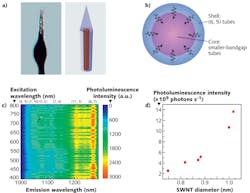CARBON NANOTUBES: Homogeneous carbon nanotubes concentrate excitons
Carbon nanotubes are being researched and refined for use as biomolecule tags for identifying cancer, as wavelength-conversion elements within planar communications devices, and in the form of coatings for radiation absorption and other emerging functions.
A team of researchers is about to expand this applications list even further through its construction of electronically homogeneous single-wall carbon-nanotube (SWNT) materials with dimensions much larger than typical excitation wavelengths of interest.1 The Massachusetts Institute of Technology (MIT; Cambridge, MA), Sony Corp. (Kanagawa, Japan), Kyungwon University (Gyeonggi-do, South Korea), Purdue University (West Lafayette, IN), and Universidade Federal de Minas Gerais (Belo Horizonte, Brazil) researchers have already demonstrated an exciton antenna and envision many other future photonic devices that could make use of the exciton-concentrating structures, including photodiodes, photovoltaics, and bolometers.
Homogeneity is key
Using an automated dielectrophoresis (DEP) drawing apparatus, the research team assembled aligned fibers with controlled length and diameter (up to 4 μm) from semiconductor SWNT solutions. The DEP process creates electronically and optically homogeneous fibers—meaning that all the SWNTs in one DEP layer are semiconducting and have the same bandgap. After creating the core layer of SWNTs via DEP, the fiber is dipped into a second solution of SWNTs with different characteristics: Namely, this outer layer consists of SWNTs with a bigger bandgap than the inner layer such that the fiber can funnel excitons (an exciton being defined as the bound state of an electron and an electron hole) from this outer shell to the inner core (of smaller bandgap SWNTs) and emit light in the near-infrared (NIR) region. A typical 14 μm long fiber can contain as many as 3.3 × 107 SWNTs, housed in structures larger than the wavelength of the absorbing light.
A series of experimental and modeling exercises shows a sharp, reversible decay in photoluminescence for the fibers when cycled from ambient temperature to temperatures on the order of 357 K, indicating that the device efficiency is best at room temperature; at high temperature the excitons annihilate each other and can no longer contribute to the optical device. This finding should stimulate researchers to think about ways to create antennas that will function optimally in high-temperature environments as well. In addition, wavelength shifts are observed along the length of the fiber structures due to inconsistencies in the fiber diameter and in the concentration and packing structure of the SWNTs within the core and shell regions.
An exciton antenna
By creating a structure consisting of successive layers of smaller-to-larger bandgap SWNTs radiating outward, excitons are able to transfer their energy to the core of the structure, effectively acting as "concentrators" for exciton energy—essentially, an exciton antenna (see figure).
"The SWNT optical antennas that capture and concentrate light energy could potentially realize much tinier and more efficient photovoltaic arrays," says MIT professor Michael S. Strano. "In addition, the optical-antenna approach demonstrated is similar to biological methods of photon concentration that have been studied extensively. Photosynthetic reaction centers in plant photosynthesis, for example, contain light-harvesting antennae in light-harvesting complex proteins that funnel excitation to a specific location. This similarity may allow new applications in which the exciton energy transfer from antenna structures to biological chromophores occurs."
REFERENCE
1. J.-H. Han et al., Nature Mats. online, doi: 10.1038/NMAT2832 (Sept. 12, 2010).
About the Author

Gail Overton
Senior Editor (2004-2020)
Gail has more than 30 years of engineering, marketing, product management, and editorial experience in the photonics and optical communications industry. Before joining the staff at Laser Focus World in 2004, she held many product management and product marketing roles in the fiber-optics industry, most notably at Hughes (El Segundo, CA), GTE Labs (Waltham, MA), Corning (Corning, NY), Photon Kinetics (Beaverton, OR), and Newport Corporation (Irvine, CA). During her marketing career, Gail published articles in WDM Solutions and Sensors magazine and traveled internationally to conduct product and sales training. Gail received her BS degree in physics, with an emphasis in optics, from San Diego State University in San Diego, CA in May 1986.
